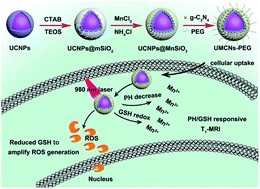当前位置:
X-MOL 学术
›
Biomater. Sci.
›
论文详情
Our official English website, www.x-mol.net, welcomes your feedback! (Note: you will need to create a separate account there.)
Multifunctional UCNPs@MnSiO3@g-C3N4 nanoplatform: improved ROS generation and reduced glutathione levels for highly efficient photodynamic therapy
Biomaterials Science ( IF 6.6 ) Pub Date : 2017-10-10 00:00:00 , DOI: 10.1039/c7bm00798a Lili Feng 1, 2, 3, 4, 5 , Fei He 1, 2, 3, 4, 5 , Yunlu Dai 1, 2, 3, 4, 5 , Shili Gai 1, 2, 3, 4, 5 , Chongna Zhong 1, 2, 3, 4, 5 , Chunxia Li 6, 7, 8, 9 , Piaoping Yang 1, 2, 3, 4, 5
Biomaterials Science ( IF 6.6 ) Pub Date : 2017-10-10 00:00:00 , DOI: 10.1039/c7bm00798a Lili Feng 1, 2, 3, 4, 5 , Fei He 1, 2, 3, 4, 5 , Yunlu Dai 1, 2, 3, 4, 5 , Shili Gai 1, 2, 3, 4, 5 , Chongna Zhong 1, 2, 3, 4, 5 , Chunxia Li 6, 7, 8, 9 , Piaoping Yang 1, 2, 3, 4, 5
Affiliation

|
Photodynamic therapy (PDT) is a novel technique that has been extensively employed in cancer treatment; it utilizes reactive oxygen species to kill malignant cells. However, poor performance of the photosensitizer itself, limited penetration depth and the overexpression of glutathione (GSH) in cancer cells are the major obstacles facing the actual clinical application of PDT. Inspired by the challenges mentioned above, here we propose multifunctional nanoparticles utilizing mesoporous manganese silicate (MnSiO3)-coated upconversion nanoparticles (UCNPs) as nanocarriers for loading highly fluorescent graphitic-phase carbon nitride quantum dots (g-C3N4 QDs) to simultaneously act as a photosensitive drug and imaging agent. Surface modification of the nanoparticles with polyethylene glycol (PEG) endows the samples (denoted as UMCNs-PEG) with excellent biocompatibility and long-term in vivo circulation. Taking advantage of the inherent performance of the as-synthesized nanoparticles, multimodality imaging, including upconversion luminescence (UCL), computed tomography (CT) and magnetic resonance imaging (MRI), has been achieved; this is conducive to providing effective treatment information by real-time monitoring. In vivo photodynamic therapy to achieve effective tumor inhibition was then realized without inducing significant toxicity to treated mice. As a result, this work provides a novel paradigm with highly integrated functionalities which not only exhibits excellent prospects for imaging-guided photodynamic anticancer therapy but also encourages further exploration of new types of multifunctional nanoparticles for biomedical applications.
中文翻译:

多功能UCNPs @ MnSiO 3 @gC 3 N 4纳米平台:改善了ROS的产生并降低了谷胱甘肽水平,从而实现了高效的光动力疗法
光动力疗法(PDT)是一种已广泛用于癌症治疗的新技术。它利用活性氧来杀死恶性细胞。但是,光敏剂本身的性能差,渗透深度有限以及谷胱甘肽(GSH)在癌细胞中的过度表达是PDT实际临床应用面临的主要障碍。受上述挑战的启发,我们在此提出了一种多功能纳米颗粒,该纳米颗粒利用介孔硅酸锰(MnSiO 3)包覆的上转换纳米颗粒(UCNPs)作为纳米载体,用于装载高荧光石墨相氮化碳量子点(gC 3 N 4QDs)同时用作光敏药物和显像剂。用聚乙二醇(PEG)对纳米颗粒进行表面修饰,使样品(表示为UMCNs-PEG)具有出色的生物相容性和长期体内循环。利用合成后的纳米颗粒的固有性能,实现了包括上转换发光(UCL),计算机断层扫描(CT)和磁共振成像(MRI)在内的多模态成像;这有利于通过实时监控提供有效的治疗信息。体内然后实现了光动力学疗法,以实现有效的肿瘤抑制,而不会对经治疗的小鼠产生明显的毒性。结果,这项工作提供了具有高度集成功能的新颖范例,不仅为成像引导的光动力抗癌治疗展现了极好的前景,而且还鼓励了对生物医学应用的新型多功能纳米颗粒的进一步探索。
更新日期:2017-11-22
中文翻译:

多功能UCNPs @ MnSiO 3 @gC 3 N 4纳米平台:改善了ROS的产生并降低了谷胱甘肽水平,从而实现了高效的光动力疗法
光动力疗法(PDT)是一种已广泛用于癌症治疗的新技术。它利用活性氧来杀死恶性细胞。但是,光敏剂本身的性能差,渗透深度有限以及谷胱甘肽(GSH)在癌细胞中的过度表达是PDT实际临床应用面临的主要障碍。受上述挑战的启发,我们在此提出了一种多功能纳米颗粒,该纳米颗粒利用介孔硅酸锰(MnSiO 3)包覆的上转换纳米颗粒(UCNPs)作为纳米载体,用于装载高荧光石墨相氮化碳量子点(gC 3 N 4QDs)同时用作光敏药物和显像剂。用聚乙二醇(PEG)对纳米颗粒进行表面修饰,使样品(表示为UMCNs-PEG)具有出色的生物相容性和长期体内循环。利用合成后的纳米颗粒的固有性能,实现了包括上转换发光(UCL),计算机断层扫描(CT)和磁共振成像(MRI)在内的多模态成像;这有利于通过实时监控提供有效的治疗信息。体内然后实现了光动力学疗法,以实现有效的肿瘤抑制,而不会对经治疗的小鼠产生明显的毒性。结果,这项工作提供了具有高度集成功能的新颖范例,不仅为成像引导的光动力抗癌治疗展现了极好的前景,而且还鼓励了对生物医学应用的新型多功能纳米颗粒的进一步探索。



























 京公网安备 11010802027423号
京公网安备 11010802027423号